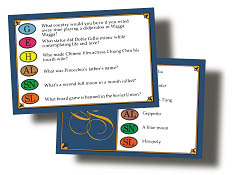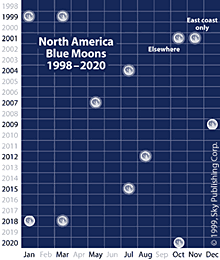The
year 1999 has two blue Moons. It's a little like
getting paid every second Friday and finding that some
months you get paid three times instead of twice.
THIS YEAR, as you've probably heard by now, we are having blue Moons. Two, in fact. If you live in North America or Europe, a pair of full Moons occurs in January and then another pair in March. In other parts of the world the phenomenon happens in April or May. While everybody experiences the Moon's fullness at the same time, our local clocks differ, and this sometimes pushes the event into the previous or next month.
"According to old folklore," some people say, the second full Moon in a calendar month is called a "blue Moon." They go on to explain that this is the origin of the expression "once in a blue Moon." But it isn't true! The term "blue Moon" has been around a long time, well over 400 years, but its calendrical meaning has become widespread only in the last 20 years.
In fact, the very earliest uses of the term were remarkably like saying the Moon is made of green cheese. Both were obvious absurdities, about which there could be no doubt. "He would argue the Moon was blue" was taken by the average person of the 16th century as we take "He'd argue that black is white."
The concept that a blue Moon was absurd (the first meaning) led eventually to a second meaning, that of "never." The statement "I'll marry you, m'lady, when the Moon is blue!" would not have been taken as a betrothal in the 18th century.
But there are also historical examples of the Moon actually turning blue. That's the third meaning — the Moon appearing blue in the sky. When the Indonesian volcano Krakatoa exploded in 1883, its dust turned sunsets green and the Moon blue all around the world for the best part of two years. In 1927, the Indian monsoons were late arriving and the extra-long dry season blew up enough dust for a blue Moon. And Moons in northeastern North America turned blue in 1951 when huge forest fires in western Canada threw smoke particles up into the sky.
So, by the mid-19th century, it was clear that visibly blue Moons, though rare, did happen from time to time — whence the phrase "once in a blue Moon." It meant then exactly what it means today, a fairly infrequent event, not quite regular enough to pinpoint. That's meaning number four, and today it is still the main one.
But meaning is a slippery substance, and I know of a half dozen songs that use "blue Moon" as a symbol of sadness and loneliness. The poor crooner's Moon often turns to gold when he gets his love at the end of the song. That's meaning number five: check your old Elvis Presley or Bill Monroe records for more information.
And did I mention a slinky blue liquid in a cocktail glass, one that requires curaçao, gin, and perhaps a twist of lemon? That's number six.
Finally we arrive at the most recent meaning of all, the second full Moon in a month. I first heard it in 1988. At the end of May that year, when a second full Moon occurred, radio stations and newspapers everywhere carried an item on this bit of "old folklore," as they called it, drawing on an international wire story. Across North America the blue Moon caught the public's imagination. In the following months, restaurants, clothing stores, and bookstores opened under the name "Blue Moon." An artist I know did a set of night landscapes that month; he calls them his Blue Moon series. At the Memorial University of Newfoundland Folklore & Language Archive we get calls from all over, from people wondering about bits of folklore. And that month we got calls about blue Moons.
I searched high and low for an earlier example of this usage, or any other name for two full Moons in a single calendar month. But the search was in vain — this meaning seemed to have no history. I did find information on the other meanings of "blue Moon," but not this one, number seven.
Then in December 1990, with another "blue Moon" coming on, I started getting more calls and decided to write about it in the local newspaper. I searched harder this time, exhausting all the usual sources: specialized dictionaries, indexes of proverbial sayings, and regional collections of folklore. A brand-new edition of the huge Oxford English Dictionary had recently come out, but even it omitted this particular meaning. "Blue Moon" seemed to be a truly modern piece of folklore, masquerading as something old.

Then my brother-in-law reminded me that the term was a question in one of the Trivial Pursuit boxes, the Genus II edition published in 1986. I hope the manufacturer of this game is still the fine company for scholars it was then. They had kept all their files and were able to tell me their source had been a children's book published the previous year, The Kids' World Almanac of Records and Facts (New York, 1985: World Almanac Publications). Where the authors, Margo McLoone-Basta and Alice Siegel, got it, no one seemed to know.
 Used
in this way, the term was certainly very, very local before they included
it in their book. It seemed never to have been written down before. Of
course, authors sometimes "invent" information to protect themselves against
plagiarists. Well, if that were the case they'd already lost, because
the new "blue Moon" almost immediately entered the folklore of the modern
world. It became as living a meaning as any of its predecessors.
Used
in this way, the term was certainly very, very local before they included
it in their book. It seemed never to have been written down before. Of
course, authors sometimes "invent" information to protect themselves against
plagiarists. Well, if that were the case they'd already lost, because
the new "blue Moon" almost immediately entered the folklore of the modern
world. It became as living a meaning as any of its predecessors.
During my search it hadn't occurred to me that radio might have played a role. My newspaper column had just gone to the printer when I got a copy of the December 1990 Astronomy. There, Deborah Byrd mentioned the term coming from a March 1946 article in Sky & Telescope (page 3). Contacting her, I found out she had read it for her National Public Radio program, Star Date, in late January 1980. No doubt that's where the authors of the children's almanac heard it. Clearly, Byrd's radio broadcast got the recent "blue Moon" ball rolling.
By the way, the 1946 note, written by J. Hugh Pruett, sends the reader back to a question-and-answer column in Sky & Telescope for July 1943 (page 17). Its compiler, L. J. Lafleur, quoted the 1937 Maine Farmers' Almanac. And there the trail goes cold: I've never been able to find an earlier trace. If a reader has any other pre-1943 reference to a calendrical "blue Moon," please tell me about it. As they were 56 years ago, Sky & Telescope readers will be the first to know!
Since 1990 I've been in touch with hundreds of people suggesting the origin of meaning number seven. Two possibilities stand out, but neither has the evidence needed to nail it down. Both are still open.
One comes from a family who emigrated from Czechoslovakia to the United States three generations ago. A member of the family told me her grandparents used the term this way, and she thought they were translating from their native language, Czech. But I've checked with several native speakers of Czech and found nothing like "blue Moon."
Secondly, an e-mail correspondent told me several years ago that calendar printers would always print a full Moon in red except when it was the second one in a month; then it would be printed in blue! That sounded wonderfully plausible — until I looked at older calendars and found none that were so.
Our new blue Moon has something of the modern times in it, a technical aspect that most of the earlier meanings lacked. Perhaps that's why it caught on so quickly. It appeals to our modern sensibilities, including our desire to have plausible origins. But any folklorist will tell you that plausibility is the mantle that folklore wears to sneak through history's lines. "Old folklore" it is not, but real folklore it is. Given its present popularity, it may last a long time.
Philip Hiscock is Archivist at the Folklore & Language Archive, Memorial University of Newfoundland. E-mail: philip@morgan.ucs.mun.ca. This article is an update of earlier versions that appeared in the Planetarian (December 1993) and Griffith Observer (July 1996).
